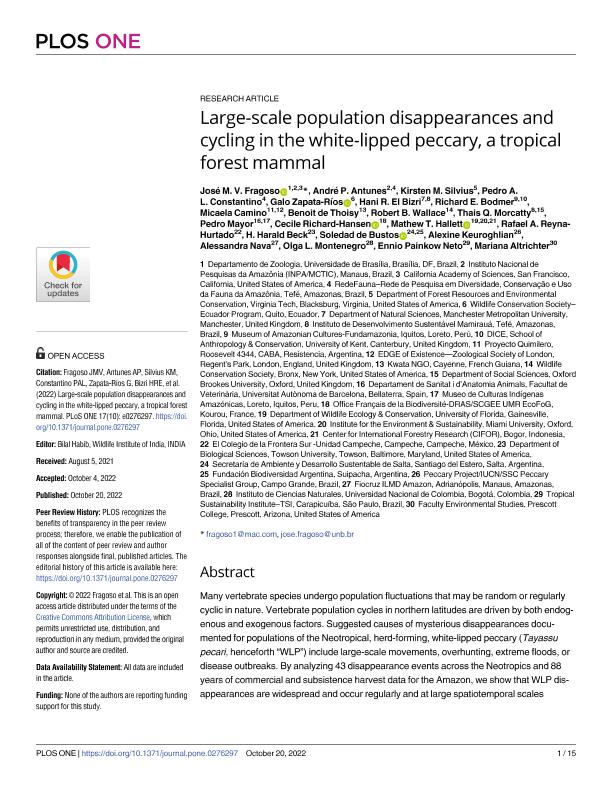Artículo
Large-scale population disappearances and cycling in the white-lipped peccary, a tropical forest mammal
Fragoso, José M. V.; Antunes, André P.; Silvius, Kirsten M.; Constantino, Pedro A. L.; Zapata Ríos, Galo; El Bizri, Hani R.; Bodmer, Richard E.; Camino, Micaela ; de Thoisy, Benoit; Wallace, Robert B.; Morcatty, Thais Q.; Mayor, Pedro; Richard Hansen, Cecile; Hallett, Mathew T.; Reyna Hurtado, Rafael A.; Beck, H. Harald; de Bustos, María Soledad; Keuroghlian, Alexine; Nava, Alessandra; Montenegro, Olga L.; Neto, Ennio Painkow; Altrichter, Mariana
; de Thoisy, Benoit; Wallace, Robert B.; Morcatty, Thais Q.; Mayor, Pedro; Richard Hansen, Cecile; Hallett, Mathew T.; Reyna Hurtado, Rafael A.; Beck, H. Harald; de Bustos, María Soledad; Keuroghlian, Alexine; Nava, Alessandra; Montenegro, Olga L.; Neto, Ennio Painkow; Altrichter, Mariana
 ; de Thoisy, Benoit; Wallace, Robert B.; Morcatty, Thais Q.; Mayor, Pedro; Richard Hansen, Cecile; Hallett, Mathew T.; Reyna Hurtado, Rafael A.; Beck, H. Harald; de Bustos, María Soledad; Keuroghlian, Alexine; Nava, Alessandra; Montenegro, Olga L.; Neto, Ennio Painkow; Altrichter, Mariana
; de Thoisy, Benoit; Wallace, Robert B.; Morcatty, Thais Q.; Mayor, Pedro; Richard Hansen, Cecile; Hallett, Mathew T.; Reyna Hurtado, Rafael A.; Beck, H. Harald; de Bustos, María Soledad; Keuroghlian, Alexine; Nava, Alessandra; Montenegro, Olga L.; Neto, Ennio Painkow; Altrichter, Mariana
Fecha de publicación:
10/2022
Editorial:
Public Library of Science
Revista:
Plos One
ISSN:
1932-6203
Idioma:
Inglés
Tipo de recurso:
Artículo publicado
Clasificación temática:
Resumen
Many vertebrate species undergo population fluctuations that may be random or regularly cyclic in nature. Vertebrate population cycles in northern latitudes are driven by both endogenous and exogenous factors. Suggested causes of mysterious disappearances documented for populations of the Neotropical, herd-forming, white-lipped peccary (Tayassu pecari, henceforth “WLP”) include large-scale movements, overhunting, extreme floods, or disease outbreaks. By analyzing 43 disappearance events across the Neotropics and 88 years of commercial and subsistence harvest data for the Amazon, we show that WLP disappearances are widespread and occur regularly and at large spatiotemporal scales throughout the species’ range. We present evidence that the disappearances represent 7–12-year troughs in 20–30-year WLP population cycles occurring synchronously at regional and perhaps continent-wide spatial scales as large as 10,000–5 million km2. This may represent the first documented case of natural population cyclicity in a Neotropical mammal. Because WLP populations often increase dramatically prior to a disappearance, we posit that their population cycles result from over-compensatory, density-dependent mortality. Our data also suggest that the increase phase of a WLP cycle is partly dependent on recolonization from proximal, unfragmented and undisturbed forests. This highlights the importance of very large, continuous natural areas that enable source-sink population dynamics and ensure re-colonization and local population persistence in time and space.
Palabras clave:
Population Cycles
,
Peccary
,
Habitat
,
Population Crashes
Archivos asociados
Licencia
Identificadores
Colecciones
Articulos(CECOAL)
Articulos de CENTRO DE ECOLOGIA APLICADA DEL LITORAL (I)
Articulos de CENTRO DE ECOLOGIA APLICADA DEL LITORAL (I)
Citación
Fragoso, José M. V.; Antunes, André P.; Silvius, Kirsten M.; Constantino, Pedro A. L.; Zapata Ríos, Galo; et al.; Large-scale population disappearances and cycling in the white-lipped peccary, a tropical forest mammal; Public Library of Science; Plos One; 17; 10-2022; 1-15
Compartir
Altmétricas



